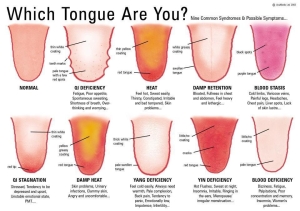The tongue is a part of the interior of our bodies that we can see. The tongue is slower to change as compared to the pulse. By using both tongue and pulse diagnosis, acupuncturists are able to get a clear picture of a patient’s current state of health, and what what may have gotten him/her there.
Many patients have a combination of patterns occurring at the same time, making real world diagnosis more complicated than the straightforward explanations below. First we will look at the tongue body then the tongue coating.
![]() Normal Tongue
Normal Tongue
A normal tongue is pink, not too big and not too small, with a very thin white coating.
Tongue Body
![]() Jutting Tongue
Jutting Tongue
This tongue to “v” shaped and juts out forcefully. The tension in the tongue is indicative of the tension held in the body. It is a sign of Liver excess (Liver Qi Stagnation or Fire). Possible symptoms include muscle tension, stress, irritability, depression, and PMS. If the tongue veers to one side this indicates Liver Wind and potentially stroke or convulsions.
![]() Puffy Tongue
Puffy Tongue
Also known as a enlarged or fat tongue. This indicates Phlegm and is a sign of congestion of body fluids. Phlegm is implicated in many modern diseases including sinus or lung congestion, excess weight, irrational thinking, obsessive thoughts, fatigue, foggy thinking, chronic joint pain, high cholesterol, polycystic ovarian syndrome, and channel blockages.
![]() Small Tongue
Small Tongue
A tongue that is smaller than normal indicates a deficiency of substance in the body, namely Blood Deficiency or Yin Deficiency. Common symptoms include anxiety, restlessness, tinnitis, insomnia, night sweats, and female hormone deficiency.
 Scalloped Tongue
Scalloped Tongue
Teeth marks on the sides of the tongue indicates Spleen Qi Deficiency. This can present as weak digestion, food allergies, fatigue, poor muscle tone, a tendency to bruise, low immunity, and organ prolapse.
Assessing Tongue Color
 Red indicates Heat (inflammation and/or toxicity). Symptoms can include thirst, constipation, irritability, acne, excess hunger, bad breath, strong body odor, and excessive bleeding.
Red indicates Heat (inflammation and/or toxicity). Symptoms can include thirst, constipation, irritability, acne, excess hunger, bad breath, strong body odor, and excessive bleeding.
 Pallor indicates Cold or Deficiency (Qi, Blood, and/or Yang). Symptoms may include feeling cold, fatigue, emotional sensitivity, insomnia, lack of physical strength, and knee and low back weakness.
Pallor indicates Cold or Deficiency (Qi, Blood, and/or Yang). Symptoms may include feeling cold, fatigue, emotional sensitivity, insomnia, lack of physical strength, and knee and low back weakness.
![]() Purple or bluish indicates Blood Stagnation. Physical trauma, longstanding emotional stress, uterine fibroids, heart issues, or other conditions impeding healthy blood circulation. There may be difficulty sleeping, stubborn depression, pain, stiffness, and stuck emotional patterns.
Purple or bluish indicates Blood Stagnation. Physical trauma, longstanding emotional stress, uterine fibroids, heart issues, or other conditions impeding healthy blood circulation. There may be difficulty sleeping, stubborn depression, pain, stiffness, and stuck emotional patterns.
![]() Red Tip The very tip of the tongue corresponds to the Heart. A red tip indicates Heart Heat, or emotional unrest. This can manifest as stress, anxiety, or insomnia. If the tip has a cleft it indicates longstanding or constitutional tendency towards emotional issues. Petechiae (little red dots) indicate Wind Heat; a cold with fever and yellow phlegm, typically bacterial in origin.
Red Tip The very tip of the tongue corresponds to the Heart. A red tip indicates Heart Heat, or emotional unrest. This can manifest as stress, anxiety, or insomnia. If the tip has a cleft it indicates longstanding or constitutional tendency towards emotional issues. Petechiae (little red dots) indicate Wind Heat; a cold with fever and yellow phlegm, typically bacterial in origin.
Tongue Coating
 Thick White Coat
Thick White Coat
A thick tongue coating indicates Dampness. This is a pathological accumulation of fluids associated with digestive impairment. Common signs include weight gain, abdominal bloating, cloudy urination, mucous in the stools, edema, excessive vaginal discharge, poor digestion, and loose stools.
Thin Yellow Coat
The coating is thin, but distinctly yellow. This indicates Heat, either internal (inflammation) or Wind Heat (cold with fever, typically bacterial in origin).
 Thick Yellow Coat
Thick Yellow Coat
The tongue appears heavily coated and yellow. This indicates Damp Heat, the combination of Dampness and Heat (fluid accumulation mixed with inflammation). Commons symptoms include excess weight, feeling hot, anger, Liver/Gallbladder issues, and red weepy skin conditions.
 Scanty or Mirrored Coat
Scanty or Mirrored Coat
The tongue looks shiny, like liver. This indicates Yin Deficiency and the patient may present with insomnia, anxiety, fatigue, thirst, low back pain, tinnitis, hot flashes, and night sweats.






